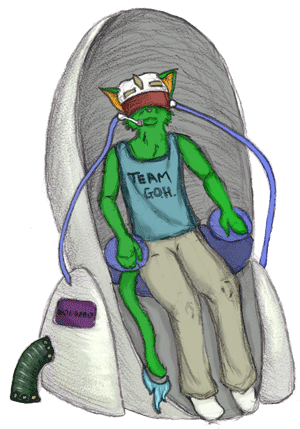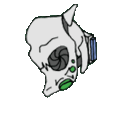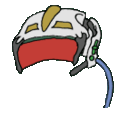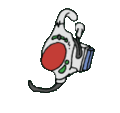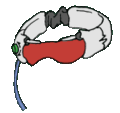Menlo
Menlo is a very realistic Augmented Reality game. It is real in every sense except for the fact that you cannot die in the game. Movement, physics, pain, and damage are all real factors during game play, and are played out exactly as they would be in real life.
Menlo players have cards which hold the data of different mechanical suits on them. The suits are basically robotic extensions or exoskeletons of the player, like a large robot that is controlled by the player inside. These suits are constructed through the player’s own mechanical genius and ingenuity. Cards are programmed with the information of the suit and the player uses this suit during game play. The players and their suits are all pitted against each other in a fight to the virtual death.
Menlo is a very diverse and customizable game. The suits can be constructed to your exact liking, and there is a vast Menlo offshoot that programmers and mechanics have created. Those with mechanical abilities create their own Game Boards, cards, headsets, everything. It is a highly versatile game that has evolved over time with the ingenuity of pendragons.
Contents
Game Play
It is difficult to give a set or rules for Menlo because anyone who makes their own Game Board or reprograms an existing one can make any set of rules they desire. Rules for any game will be given to the players by the owner of the Game Board before the actual game begins; at least you hope they will. Outlined here will be the typical MCC outline of the rules and game play.
In a typical match, the players are entered into the virtual reality at equal intervals on the edges of the world. There is a short probationary period in which suits cannot be moved. During this time, players can go over their suits and make any necessary last minute modifications or adjustments. When the probationary period is over, a sharp siren will sound, signifying the beginning of the match. Then, players will hunt out their opponents. Fights are Free-For-Alls (FFA) where any fighting method is allowed. A game ends when one player is left standing, and all other players have been killed or disabled. Players cannot actually die in the game, but they will still feel the pains of the blows. When they "die," they will be extracted from the game, and wake up in reality.
A player "dies" (loses) in the game when they are mortally injured, pass out, surrender, or their suit is rendered incapable of moving or functioning. After a match, damage done to suits is not saved (typically. Some mechanics find it fun to force the losers to repair their suits). Suits will be in perfect condition when their next fight is started.
Rules and Regulations
The rules depicted here are in no way uniform, except those of the Arena. Game Board rules are as diverse as possibly imaginable. Anything goes, so long as all players agree. This is simply an outline of general rules that are typically addressed.
Arena Match
In an Arena match, game play is a little different. Only two players can compete in an Arena match, and they appear in the virtual reality at opposite ends. Every environment for a tournament is different, and random. Neither player is allowed to know the nature of the virtual reality before the fight. This forces players to be prepared for anything, and tests the integrity of their suits under all conditions. If they are found to have knowledge of the environment beforehand, and they do not inform the proper game authorities, they will not be allowed to compete, and the victory will be given to the opposing player. The probationary period is a little longer in Arena matches, and suits are rendered completely inoperable during this time. A referee suit (operated by a pendragon who will oversee the fight) appears in the center of the virtual reality at the end of the probationary period, and sounds the beginning siren. The referee usually has nothing to do, since the fights have no rules, and the machines can usually catch any discrepancies. They are there for formality, and to possibly catch any new aspects that a player may have developed to get around regulations and rules. The last remaining player wins the match, and they are awarded with the tournament prize.
Arena matches can be seen by the audience in the stand through a large Hologram Glass Room set up in the center of the arena. This room displays the virtual reality and the players inside it. The players cannot see or hear the audience, but the audience is treated with graphic sound from the fight blared loudly over the stadium speakers. The Hologram room displays the two players at either edge, zooming closer in and out as the players get closer and further from each other. This way, in the nitty-gritty of the fight, the audience can see clearly and hugely, every detail.
- Only two players may be in a match at a time.
- Menlo cards must be 4in by 3in by 1in in size, with no add-ons, and must be compatible with standard Arena programs.
- No player may know the setting of the Arena at any time before the official match. If a player knows the setting of an Arena, failure to come forward and alert an official will result in forfeit for that player and victory for the opponent.
- Viruses are not forbidden in Arena matches. Any player that is found to have installed a virus in their card will be banned from any further competitions.
- You may not purposefully injure the referee. If a player does, the apposing player may choose a replacement referee even if that referee is in allegiance with them. (Not a very serious offence)
- Your suit may not be designed to have separate components. All components on the suit must be intended to stay on the suit throughout the entire match. For example, you may not program a ‘rover’ that detaches from your suit to scout out the land into your card. This does not include projectile weapons.
Game Board Match
- As many players as are desired may participate in a single match.
- All players must agree on the rules before they start the match.
- There is no regulation size card, so long as it is possible to plug the card into the Game Board generator the match is taking place in, it is allowed.
- Since the standard Game Boards are of a limited variety, players will typically know the setting of the match before hand. For this reason, it is customary to inform all players of the setting before a match to eliminate any possibly advantages. However, those who make their own Game Boards and new, unknown environments, often mess with this rule as they see fit.
- In some matches, viruses are also considered a part of the game. As are virus blockers and such. However, viruses that are made to affect the actual Game Board system itself are not typically allowed. Some amateur virus players can have their viruses get ‘stuck’ in other player’s suits or Game Board generators. This is punishable by law as destruction of property, so virus players usually agree before hand not to charge each other, or they simply take their chances and rely on their coding skills.
- Again, in some matches detachable components are part of the game.
Cards
Cards are basically regulation size mechanical components. They are typically much larger and wider than playing cards, also much heavier. They are more comparable to a very dense cassette tape, or VHS. Every card is encrypted with a different suit. This way, it is simple to select your preferred fighter for every fight, and display your collection to friends. Cards are inserted into an Arena, Game Board (see Arenas and Game Boards below), or Headset, and then the player will arrive in the game in this suit.
Cards can really be any size, though there is a standard size that is used by the Menlo Competitions Corporation (MCC) and all their products are produced to use this standard size. This size is roughly 4in by 3in by 1in in terran measurements. However, due to the amount of homemade equipment, cards can come in basically any size. Players can and sometimes do make their own size cards and Game Boards to utilize these cards so that they can either have more card space for more complex coding, or less to test their abilities at simple, concise coding. However, the standard MCC size is the most widely used.
Cards can look like anything really. Basic MCC cards are just circuitry in a metal case with various plugs and input holes lining the edges, a circling picture of the suit in the card on the front, and a little sticker on the back with the fields “Card Name”, and “Player Name” on it so that the player can fill in the fields. Unlike size, appearance is virtually inconsequential in the card’s ability to function. In other words, pretty much whatever it looks like, so long as it has the right plugs and size, it will work.
Coding
Constructing a suit is very difficult and complicated. There are two ways to construct a suit. The first method is more accepted and utilized by the ‘computer geek’ player base of Menlo. This is the method of constructing or purchasing a card ‘cast’ or empty card and plugging it into a computer. Then, the card is loaded into any of a variety of coding programs. Then, the geek does their thing, carefully and painstakingly encoding their suit. The coding describes the way the suit will look and function. The second method is used by the ‘mechanics’ who prefer to get their hands dirty. An empty card cast is plugged into a specialized ‘Building’ or ‘Construction’ Game Board. Then, the player enters the game, and constructs the suit in the game, using parts and materials in the Game Board.
Card casts are basically empty cards with a portion of the card already taken up by a shell of a suit. These cards are sold by MCC, and other manufacturers for aspiring players to more easily construct their own cards. However, some advanced players simply begin their cards from scratch without any cast whatsoever.
When constructing a suit, physical limitations exist. The inside of a suit cannot be larger than that of the outside, parts of the suit cannot overlap each other without physically being able to do so (For example, a protrusion going through a metal plate will need a hole in the metal for it to go through, and cannot just sorta holographically go through). Also, only materials that exist on Ramath-lehi can be used in construction of a suit. There are no invisible metals or unbreakable glass. Everything has a weakness, and there are no super-break-everything rays or swords, or block-everything shields. The durability of a suit depends on craftsmanship and ability to code.
Coding of a suit will consist mainly of powering systems and general setup of the suit. This does not logically leave much room for weapons and gadgets, or power-jumping/running/hitting etc. For this reason, smaller and more concise codes for different aspects are always sought after. The better the coder, the more that can be fit onto a card. Typical players can only fit a few specialized aspects on to their cards.
Arenas and Game Boards
Arenas and Game Boards are the components that house the information for the scene or setting of the game. They hold the information for the virtual reality world in which the suits appear, and are also encoded with the rules and restrictions of the game. Headsets and cards are plugged into the Arena or Game Board, and play ensues. Typically, cards are plugged into headsets; however there are also a couple models where the cards are plugged into the Game Board itself.
As a note, Headsets are sort of like helmets or goggles that cards are plugged into. They show the information of the game and the suit to the player before a fight begins. Screens on the headsets are typically operated through thought and mind. When the player is ready, they enter the game through their headset, and their mind is sucked into the virtual reality of the Game Board through the headset. Headsets are distributed by MCC and cannot legally be bought by anyone under 18.
There are two types of virtual reality environment generators; the Game Board, and the Arena. The Game Board is that which is used by the general public. The Arenas are used for large scale, and spectator games. Players competing in large tournaments or matches, those who are the celebrities of the game, use Arenas in their determining matches. (Arenas are the equivalent of the Football stadium)
Like everything else of Menlo, Game Boards are extremely customizable and come in hundreds of models, both official MCC, and homemade. Different Game Boards are used for different environments, different sets of rules, and different types of play (like team play, or training). Different Game Boards are used to produce a city, a jungle, or even another planet. The most common and typical Game Board made by the MCC is the City-scape. Also, different Game Boards will come with different rules and regulations, programmed to detect and bar different aspects of play such as viruses or add-ons. However, rules are easily customizable on Game Boards. Physics in the game can also be changed from Game Board to Game Board, to create moonscapes, underwater scenes, or other planets and environments.
Viruses and Add-Ons
Viruses and Add-Ons are both banned from Official and Arena matches. However, this does not stop a great population of game players to uses these aspects in their game play. Sometimes special tournaments are set up by third parties especially for these types of players.
Viruses are strings of codes that interrupt aspects of gamy play, including physics of the reality world, functionality of an opponent’s suits, and even functionality of one’s own suit. They are used to create an advantage for oneself, or a disadvantage for one’s opponent. Most viruses are put into effect right when the game begins. However, more complicated viruses can have triggers in game play. For example, close proximity of something to the suit may cause a shield to appear around the suit to block or absorb a blow. However, these types of viruses are very long and take up a lot of space.
Viruses in general are long, complicated, and take up a vast majority of card space. For this reason, virus players tend to work with larger model cards, Add-Ons, or with very simple, body-fitting suits.
Virus blockers are basically special virus shields that some virus players put in their cards to minimize or null and effect done by an opponent's virus.
Add-Ons are separate circuit components that can be plugged into a card, making the overall unit of the card and plug-in, larger than regulation size. Plugging these in will add different aspects to a suit, making it easier to customize on the spot, and also to fit more coding into a single suit. Some add-ons are designed to fit into holes in the card, so that when they are plugged in, the whole unit (card and add-on) is still regulation card size. However, this method does not add any information space to the card, simply makes it easier to customize.
History
The Menlo game was created by Serin Menlo, and the Menlo Competitions Corporation (MCC). They are responsible for all standards of the game, along with a diverse line of products sold for the game, including Arena equipment, household Game Board systems, headsets, cards, and so forth. They are also the major sponsors of many of the Menlo tournaments. They hold regular competitions, with roughly 100 official Arena matches held annually. Their main competition is held every spring (Dyo Tournament) which is meant to pit the very best Menlo players of the world against each other to come up with an annual Menlo champion.
The Pendragon most responsible for the game’s popularity is Raebin Yanq'fal. He was a young and handsome Pendragon who attracted a wide variety of fans, promoting the game in many social circles. Raebin was the only known Pendragon to win the Dyo Tournament for 3 consecutive years, and may have won many more had it not been for his unfortunate and mysterious demise during one of the matches. His cards are showcased in the MCC headquarters, along with tributes to other Menlo pioneers. He is still considered the best Menlo player ever to live.
Although Menlo is not originally a team sport, in recent years the popularity of team fighting has grown immensely. Generally, rules in these matches are those of the Arena, with the additional rule that team members must each use the same exact suit that has been made for that team. It is rumored and believed that the MCC will soon begin to sponsor official team matches as well. Also, major universities and schools may soon develop teams for aspiring players. (This is slightly different than Game Board team playing. In the Game Board team playing, players have their own, differing suits that they have made, they are simply on opposing teams.)
See Also
Menlo Images
Menlo Gear
| Menlo Gear Part Key | |
|---|---|
| Outer Shell | |
| Visor | |
| Decoration | |
| Card/Card activator link | |
| Adjustable | |
| Buttons/Controls | |
In order to participate in an Augmented Reality Menlo match, all active participants must have a head set. A head set is a modified Multi Processing Device that has been tailored specifically for Menlo game play.
A MCC R112, the very first Menlo head set. Now discontinued.
A MCC R853 head set. The second head set. Still manufactured, but not popular.
A MCC Aviator Helmet head set.
A MCC A06 head set.
A MCC P24 head set.
A MCC P57 head set. Used by professional Menlo players.
A MCC CA-257 head set.
A MCC CU-412 head set. The newest and currently best selling model.
Menlo Suits
Menlo suits, as they appear to the participants and spectators of a match.
Menlo Matches
The following are a list of roleplay threads that contain Menlo matches.
| Thread Title | Participants |
|---|---|
| Menlo Spar | Lucian and Pirate Ferret |
| At the Local Menlo Arena... | Firax, A'delos, Silith, Pirate Ferret, and Kaieta Ultima |
| Bring It | A'delos and Silith |
| Menlo Match at Magi Lake | Lautir, Kitsufox, Silith, Kwoiffei, Fused Eidolon, and Pirate Ferret |
| |||||||||||||||||
